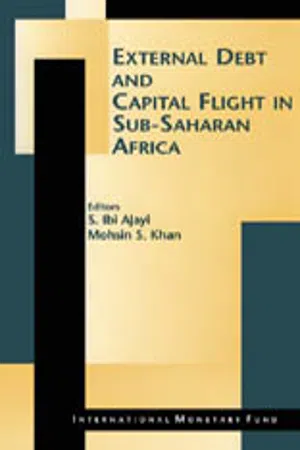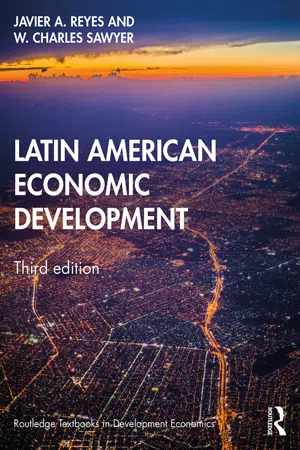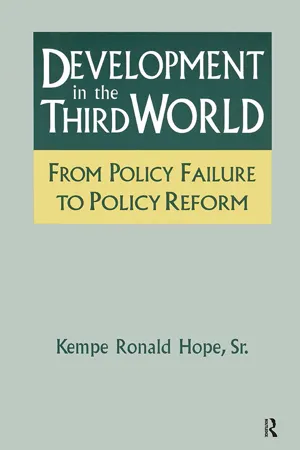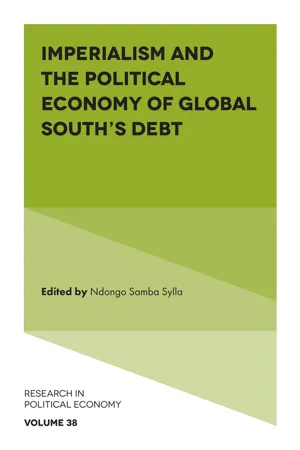Economics
Foreign Debt
Foreign debt refers to the amount of money that a country owes to foreign entities, such as other governments or international financial institutions. It is typically incurred through borrowing to finance government spending or investment. Foreign debt can have significant implications for a country's economy, including affecting its creditworthiness, exchange rates, and ability to repay the debt.
Written by Perlego with AI-assistance
Related key terms
6 Key excerpts on "Foreign Debt"
- INTERNATIONAL MONETARY FUND(Author)
- 2000(Publication Date)
- INTERNATIONAL MONETARY FUND(Publisher)
Nonetheless, external debt data used in this study are largely drawn from World Bank publications. This data source has obvious advantages. To a large extent, statistics obtained from this source are not available from official Ghanaian sources. Also, the World Bank figures enable an easy and meaningful international comparison. However, where necessary the data have been supplemented with information obtained from the Bank of Ghana.The following standard definitions, distinctions, and categorizations have been followed. External debt is defined by type. Long-term debt is debt that has an original or extended maturity of more than 12 years. Short-term debt is debt that has an original maturity of one year or less. Debt with an original or extended maturity of between 1 and 12 years is classified as medium-term debt. With regard to long-term debt, a distinction is also made between public and publicly guaranteed debt on the one hand, and private nonguaranteed debt on the other. Public and publicly guaranteed debt consists of obligations of the national government and autonomous public bodies, as well as obligations of private debtors that are guaranteed by the government. Private nonguaranteed debt consists of obligations of private debtors that are not guaranteed by the government or any public entity.Creditors are categorized as either official or private. Debt from official creditors comprises loans and credits from international organizations (multilateral donors) and loans from governments (bilateral donors) and their agencies.Total Debt
The total debt is the sum of long-term debt (public and publicly guaranteed debt and private nonguaranteed debt), medium-term debt (including IMF credits), and short-term debt. Table 2 shows Ghana’s total external debt in both current and constant dollars since 1970. The growth rates of the debt are also shown. The trends in the total debt are depicted in Figure 1 .Figure 1 . Ghana: Trends in Total Debt, 1970–90(In billions of U.S. dollars)- eBook - ePub
- Javier A. Reyes, W. Charles Sawyer(Authors)
- 2019(Publication Date)
- Routledge(Publisher)
As the data above indicates, over the 1970s and early 1980s, the external debt of Latin America increased substantially. This is not necessarily a bad thing. If the money borrowed by the governments of the region had been invested in productive assets that enhance economic growth, then a rising level of debt could be a positive thing. On the other hand, if the debt is being used to intervene in the foreign-exchange market to support an overvalued exchange rate, that is not quite so positive. In this case, a rising level of debt was buying faster economic growth in the short run at the risk of a default on the debt or lower economic growth in the future caused by a major depreciation. Like all debt, money owed by citizens, firms, or the government has to be repaid. In this case, there is one important difference. For most countries, Foreign Debt cannot be repaid in domestic currency. Repayment of Foreign Debt must be made in an acceptable foreign currency. When debt payments come due, foreign exchange must be available. In order to make timely payments on Foreign Debt, two factors become critical.As was covered in the previous chapter, countries have official reserve assets. These represent the stock of foreign exchange a country possesses at a point in time. In some time periods, inflows of foreign exchange will exceed outflows. In this circumstance, the stock of official reserve assets will rise. At other times, outflows may exceed inflows, and the stock will fall. Official reserve assets are important in that they represent a cushion of foreign exchange. If inflows of foreign exchange temporarily decrease or outflows increase, the country can still pay for imports or debt repayments if the level of official reserve assets is sufficiently high. However, if this level is extremely low, then a country may face the uncomfortable choice of imports versus debt repayments. There may not be enough foreign exchange for both.The other critical factor is the debt–export ratio - eBook - ePub
Development in the Third World: From Policy Failure to Policy Reform
From Policy Failure to Policy Reform
- Kempe Ronald Hope, Sr.(Authors)
- 2016(Publication Date)
- Routledge(Publisher)
45 These variables, and changes in them, may result from, or be amenable to influence by, the country's own choice of policies and its success in implementing them, but the pattern of future developments in a given country will also depend on some factors outside its sphere of control or direct influence. All of the arguments have led to the use of another measure for determining creditworthiness and the burden of external debt. The suggested measure is that of the ratio of total external debt to GDP. The primary reasons in support of this measure are: (1) a country's creditworthiness and its attractiveness to international lenders are determined not only by its income levels but also by its growth potential; (2) the majority of Third World countries have highly open economies; and (3) external public debt constitutes only a part of the total external debt for a number of them, and thus in some cases may considerably understate the extent of indebtedness.Within the limits of a country's international creditworthiness, Foreign Debt provides an opportunity to spend more than the national product and to borrow against the future. Judicious use of this opportunity may raise the rate of growth and provide the scope to meet the future burden without undue stress. Any analysis of the Third World countries' indebtedness over time, however, is beset by the difficulty of taking account of currency realignments and inflation. Currency realignments as well as the floating of currencies have had complex repercussions on the value of debt outstanding, the cost of debt service, the value of reserves, and trade relations in general. Even if we allow for an increase in dollar prices of Third World countries' exports, the real effect of most currency realignments has been a reduction in the debt outstanding.46Related to the effect of currency realignments is the effect of inflation on indebtedness, and this too must be taken into account. To the extent that the inflation rate is not fully reflected in setting the interest rate of a loan, inflation is beneficial to the debtor because the debtor services the debt with money that is worth less than it was when contracting the debt. The effect of inflation is of course more complicated, depending on how the prices of Third World countries' exports and imports are affected, as reflected in their terms of trade. The recent disturbances resulting from higher prices for oil, food, and other primary products have added a further dimension to the complications of debt comparisons over time.47 - Ndongo Samba Sylla, Ndongo Samba Sylla(Authors)
- 2023(Publication Date)
- Emerald Publishing Limited(Publisher)
1. In this chapter, the following concepts are used interchangeably: Global North/North/Northern/Core; Global South/South/Southern/Peripheral. The concept of external debt refers here to debt denominated in a foreign money unit of account, or foreign currency debt, to use a more intuitive concept.2. One related and crucial aspect of monetary sovereignty concerns the legal regime under which debts are issued. Issuing sovereign debt under foreign law impairs monetary sovereignty. See, for example, Pistor (2017) .3. It is not appropriate to speak of “monetization” of public debt – the issuance of noninterest-bearing securities – when the reserves of the banking sector are remunerated. Moreover, this concept has no operational reality for countries whose central banks aim to control the interest rate prevailing in the interbank market. See Felipe and Fullwiler (2022) .4. On sovereign defaults on domestic currency debt for the period 1960–2019, see Beers, Jones, and Walsh (2020) . See also Erce, Mallucci, and Picarelli (2022) . On sovereign default episodes generally for the last six decades, see Beers, Jones, Quiviger, and Walsh (2021) . Reinhart and Rogoff (2009) offered a long history of sovereign defaults. Their pro-austerity findings on the relationship between the size of government debt and economic growth (Reinhart & Rogoff, 2010 ) have been criticized due to “a series of data errors and unsupportable statistical techniques” (Herdon, Ash, & Pollin, 2013 ; Pollin & Ash, 2013 ) and for not taking into account the specific case of monetarily sovereign governments (Nersisyan & Wray, 2010 ).5. In 2020, Eurobonds issued by LMICs decreased in value by an average of 11% compared to 2019, and in particular by 74% in Sub-Saharan Africa (World Bank, 2021 , p. 14).6. The debt-to-GDP ratio has many limitations, including the fact that it compares a stock (government debt) to a flow (GDP). Although Furman and Summers (2020 , p. 18) note that this ratio is “a misleading metric of a country's fiscal position,” they nevertheless recommend “a much higher ceiling” than 60% for the US federal government debt. For a critique, see Galbraith (2020)- International Monetary Fund(Author)
- 1988(Publication Date)
- INTERNATIONAL MONETARY FUND(Publisher)
For accurate measurement of any economic variable it is necessary to have a clear concept of what is to be measured. The development of a concept implies establishing boundaries which include what is to be measured and exclude all else. One method of ensuring that this is done consistently is to construct a comprehensive framework which gives guidance with respect to the definition and classification of all related variables. Existing examples of such frameworks are: national accounts; flow of funds; and balance of payments.Unlike national accounts and balance-of-payments concepts, external debt has never been defined in a manner which has been agreed by compilers and analysts. Furthermore, the different definitions employed by international organisations and other compilers and users of data indicate that no single concept is appropriate for all uses. This points to the need for an agreed benchmark for the concept of external debt. One criterion guiding the Group’s work has been compatibility with existing well-structured systems.The term “debt” implies a liability, represented by a financial instrument or other formal equivalent. The United Nations’ System of National Accounts (SNA) defines financial assets and liabilities as:- – “the gold, currency, and other claims on (and obligations of) other parties owned by an economic agent; or the claims on (or obligations of) an economic agent owned by other parties.”
With the exception of gold and, by convention, IMF special drawing rights (SDRs), a fundamental characteristic of financial instruments is the existence of a contractual creditor/debtor relationship, i.e., one agent’s liability is another agent’s asset. Analysis of the economic impact of financial transactions is facilitated by reference to the characteristics of the different classes of financial instrument. The SNA has identified 12 categories of financial instrument, as listed in Figure 1 .Figure 1 . Financial instrumentsAs debt is a liability concept, the focus is on all instruments except gold and SDRs. The instruments vary widely in the nature of the liability involved, but instruments 2 to 8, unlike equity, involve a clear contractual obligation to pay a fixed or pre-determined variable amount of income and/or an amount of principal. These instruments may differ substantially in terms of maturity – ranging from demand deposits to perpetual bonds – and in negotiability, but all involve a contractual payment obligation which differs from that incurred by equity issuers. Instruments 9 and 10 may also include some items of a contractual nature, but cannot be included “en bloc” on the same footing as the earlier items. It is perhaps also worth noting, in connection with the future work outlined in Chapter III , how the pairing of instruments in Figure 1- eBook - ePub
- INTERNATIONAL MONETARY FUND(Author)
- 2000(Publication Date)
- INTERNATIONAL MONETARY FUND(Publisher)
4 Foreign Currency Liabilities in Debt Management
Patrick de Fontenay and Philippe JorionFor governments (or firms) that borrow, as most do, whether to issue foreign currency denominated debt, how much, and in which currencies seem to be separate decisions, subject to different considerations. Indeed, this is how many countries have approached foreign borrowing. For example, a central bank may decide it needs to replenish its stock of foreign exchange reserves and how much it should borrow abroad. The choice of currency or currencies in which to borrow is then decided separately.Historically, for many developing countries, the choice of currencies in which to denominate their Foreign Debt was imposed by the lenders, and in the absence of easy access to the swap market that choice could not be changed. For a second category of countries, the necessity of borrowing abroad was imposed by the balance of payments or official reserve situation, or by the narrowness of the domestic market for government debt, either in terms of volume, liquidity, or choice of maturities. Governments were also able to borrow on better terms than public enterprises and private firms to which they would lend the proceeds of their foreign borrowing. For those countries, the choice of currencies is an important decision to be taken as part of their external debt management. Finally, there is a third category of countries, which includes most industrial countries and several developing countries. In those countries, governments are not compelled to issue debt denominated in foreign currencies, and some choose not to. Of course, from a balance of payments standpoint, sales to nonresidents of government bonds denominated in local currency represent foreign borrowing.The first part of this paper discusses the currency composition of Foreign Debt, largely from the standpoint of the countries in the second category. The second part discusses the role of foreign currency debt in sovereign liability management and reviews the different approaches to this issue. The third part is a numerical application of modern portfolio theory to a country case.
Index pages curate the most relevant extracts from our library of academic textbooks. They’ve been created using an in-house natural language model (NLM), each adding context and meaning to key research topics.





